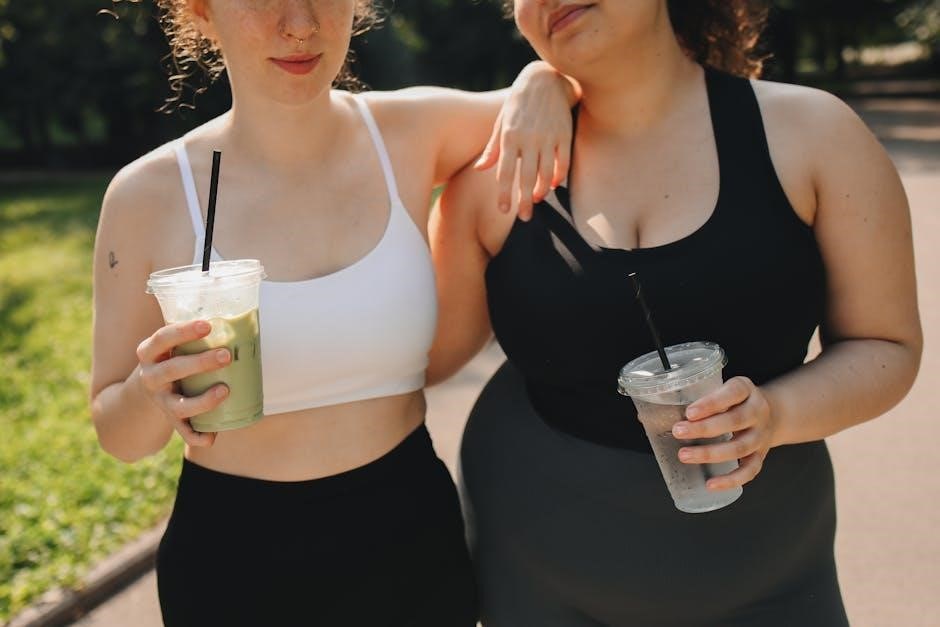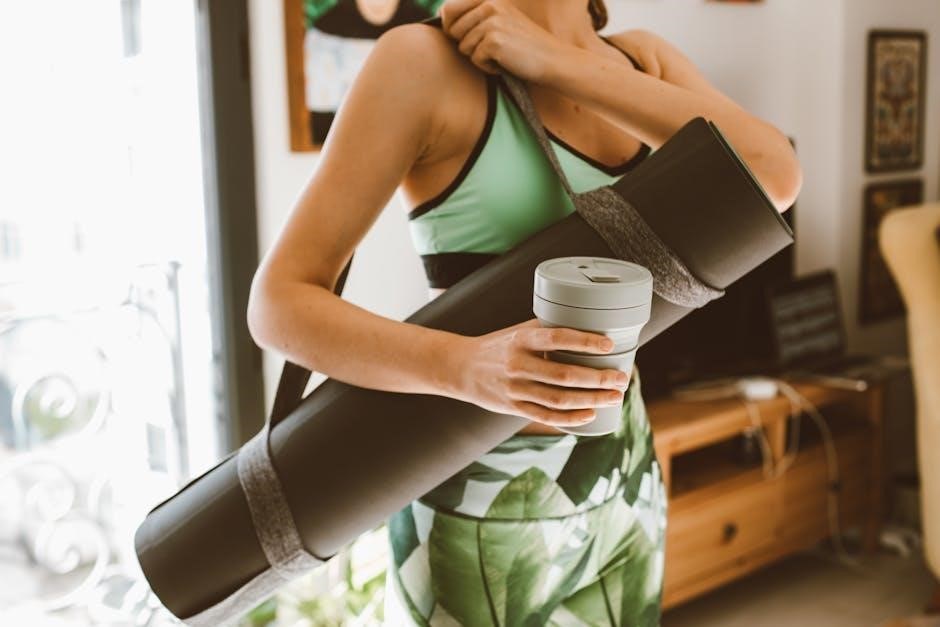Understanding your bra cup size is essential for comfort and support. This guide helps you determine the perfect fit by explaining band and cup measurements, ensuring confidence and ease.
Why Proper Bra Fit Matters
A well-fitting bra is crucial for both comfort and health. Poorly fitting bras can cause discomfort, restrict breathing, and lead to long-term issues like back pain. Proper fit ensures optimal support, reducing strain on shoulders and improving posture. It also boosts confidence and enhances the appearance of clothing.
- Poor fit can lead to health issues, such as skin irritation or breathing difficulties.
- A correct fit prevents excessive movement, providing stability during daily activities.
- It enhances overall comfort, allowing you to focus on your daily tasks without distractions.
Investing time in finding the right size ensures better health, confidence, and a more enjoyable daily experience.
Understanding Bra Size Components
Bra sizes are composed of two key measurements: the band size and the cup size. The band size is the numerical part of your bra size, representing the measurement around your rib cage in inches. The cup size is the alphabetical part, indicating the difference between your bust and band measurements; Together, these components ensure a personalized fit.
- The band size provides structural support and stability, anchoring the bra around your torso.
- The cup size determines how much breast tissue is covered, ensuring comfort and proper containment.
- Sister sizes are alternative sizes with the same cup volume but different band lengths, offering flexibility in fit.
Understanding these components is vital for selecting a bra that offers both comfort and support, tailored to your unique body shape.
How to Measure Your Bra Size
Use a flexible measuring tape to measure around your rib cage under your bust for the band size. Measure around the fullest part of your bust while keeping the tape level to determine your cup size. Subtract the band measurement from the bust measurement to find your cup size. For accurate results, ensure the tape is snug and level. Use a mirror or ask for help if needed. This method ensures a precise fit for comfort and support.
Measuring Your Band Size
To measure your band size, wrap a flexible measuring tape snugly around your rib cage, directly under your bust where a bra band would sit. Ensure the tape is level and not twisted. Stand upright and take a deep breath to relax your muscles. The measurement should be tight enough to stay in place but not so tight that it feels restrictive. If the number is odd, round up to the nearest even number, as band sizes are always even. For example, a measurement of 34 inches corresponds to a 34 band size. This measurement is crucial as it provides the foundation for your bra size. For accuracy, wear a non-padded bra or no bra during measurement. Use a mirror or ask for assistance to ensure the tape is straight and level. This step ensures a comfortable and supportive fit, as the band provides most of the bra’s support. If your measurement falls between sizes, consider trying both to determine the best fit. Different brands may have slight variations, so consulting their size charts can be helpful. Remember, the band should feel firm but not constricting, allowing for easy movement while staying securely in place. This step is the first in determining your overall bra size and ensures a proper foundation for comfort and support. Accurate band measurement is essential for a flattering and functional fit, so take your time to get it right. Measuring correctly ensures your bra stays in place all day without shifting or riding up, providing consistent comfort and confidence. By following these steps, you can determine your band size accurately and confidently.
Measuring Your Bust Size

Measuring your bust size is a crucial step in determining your bra cup size. To do this accurately, put on a non-padded bra and stand upright. Wrap a flexible measuring tape around the fullest part of your bust, ensuring the tape is parallel to the floor and not too tight. The tape should sit comfortably, neither digging into your skin nor sliding down. Take a deep breath and exhale slightly to relax your muscles. If the measurement is an even number, that’s your bust size; if it’s odd, round up to the nearest even number. This measurement, combined with your band size, will help calculate your cup size. For consistency, avoid measuring over bulky clothing or while slouching. Accurate bust measurement ensures a proper fit, preventing issues like gapping or constriction. Take your time to ensure the tape is level and snug for the best results.
Calculating Your Cup Size
Calculating your cup size involves subtracting your band size from your bust size. First, measure your bust and band as described. Subtract the band measurement from the bust measurement to find the difference. Each inch of difference corresponds to a specific cup size: 1 inch for A, 2 inches for B, 3 inches for C, and so on. For example, if your band size is 34 and your bust size is 37, the difference is 3 inches, resulting in a C cup. If the difference is between sizes, round up to the next cup size. For instance, a 2.5-inch difference is considered a C cup. This calculation ensures you find the correct cup size for optimal comfort and support. Remember, sister sizes may also be an option if your size isn’t available. Always refer to a bra size chart for accurate results.

Bra Size Chart and Conversions
This section provides a comprehensive bra size chart, including standard, plus-size, and international conversions. It helps determine your size accurately for a perfect fit.
Standard Bra Size Chart
A standard bra size chart combines band size (measured in inches or centimeters) with cup size (from AA to KK). The chart helps determine your ideal fit based on underbust and bust measurements.
- Band Size: Measured around the ribcage, it ranges from 28 to 48 inches (70 to 120 cm).
- Cup Size: Calculated by subtracting the band size from the bust size. For example, a 2-inch difference is a B cup, while a 4-inch difference is a D cup.
| Cup Size | Bust ౼ Band Difference (inches) |
| AA | 0-1 |
| A | 1-2 |
| B | 2-3 |
| C | 3-4 |
| D | 4-5 |
| DD | 5-6 |
| E | 6-7 |
| F | 7-8 |
| G | 8-9 |
| H | 9-10 |
| I | 10-11 |
| J | 11-12 |
| K | 12+ |
Use this chart to find your size, but remember fit can vary by brand. Consider professional fittings or sister sizes for the best results.

Plus Size Bra Size Chart
The plus size bra size chart is designed for individuals with larger band and cup sizes, typically catering to sizes 38 to 58 in band measurements. This chart accommodates fuller figures, offering a range of cup sizes from DD to KK, depending on the brand.
- Band Sizes: Range from 38 to 58 inches (96 to 147 cm), providing a comfortable fit for larger frames.
- Cup Sizes: Extend beyond standard sizes, offering options like DD, E, F, G, H, I, J, and KK to support fuller busts.
Each cup size represents a consistent volume, ensuring proportional fit across different band sizes. For example, a 40DD and 42DD have the same cup volume but different band lengths. This chart helps plus-sized individuals find bras that offer both comfort and adequate support.
Pro Tip: Plus size charts often include sister sizes, allowing for adjustments in band and cup combinations to achieve the best fit.
International Bra Size Conversions
Bra sizes vary across countries, making international conversions essential for finding the right fit. Different regions use unique sizing systems, so understanding these differences is crucial for shopping abroad or from international brands.
- US to UK Sizes: US sizes align closely with UK sizes. For example, a 34B in the US is equivalent to a 34B in the UK.
- US to EU Sizes: EU sizes use a different numbering system; a US 34B corresponds to an EU 75B.
- US to AU Sizes: Australian sizes are similar but differ slightly; a US 34B is an AU 12B.
- Cup Size Variations: Cup sizes also differ. For instance, a US B cup is equivalent to a UK B but may be labeled differently in other regions.
Conversions ensure consistency in fit and comfort, especially when purchasing from international brands. Always refer to a size conversion chart or consult the retailer’s sizing guide for accuracy.

Common Bra Fit Issues

Issues like cup sizes being too big or small, straps slipping, and bands riding up are common. These problems can cause discomfort and affect support.
Signs Your Cup Size is Too Big
If your cup size is too big, you may notice gaping fabric in the cups or straps that constantly slip off your shoulders. The underwire might sit on breast tissue, causing discomfort. Additionally, the bra may feel loose, offering little to no support. If the cups are too large, your breasts might not fill them properly, leading to an unflattering fit. Pay attention to these signs, as they indicate the need for a smaller cup size. Proper fit ensures maximum comfort and support, so adjusting your size can make a significant difference. Identifying these issues early helps in finding a bra that provides the right level of comfort and support for your body.
Signs Your Cup Size is Too Small
If your cup size is too small, you may experience spilling over the edges of the cups, creating an unflattering appearance. The underwire might dig into your skin, causing discomfort or even pain. Straps may feel tight or strained, and the center gore could sit uncomfortably against your chest. Additionally, the band might ride up, indicating that the cups are not providing enough coverage. These signs suggest the need for a larger cup size. Proper fit is crucial for both comfort and support, so addressing these issues can enhance your overall bra-wearing experience. Paying attention to these indicators helps ensure you find a bra that fits well and provides the necessary support for your body.
How to Adjust Your Bra Size for Better Fit
Adjusting your bra size for a better fit involves understanding your measurements and making necessary changes. If your band feels tight, consider increasing the band size while potentially decreasing the cup size. Conversely, if the band is too loose, you may need a smaller band size and possibly a larger cup size. Sister sizes can help maintain the same cup volume while adjusting the band. For example, if a 34C is too tight, try a 36B or a 32D. Use a bra sizing chart to guide your adjustments and ensure accuracy. Additionally, consult manufacturer size guides, as fit can vary between brands. Trying different sizes and styles can also help you find the most comfortable and supportive fit for your body.

Additional Tips for Finding the Perfect Bra
Explore different styles, like wireless or full-coverage bras, to suit your lifestyle. Consider sister sizes for a similar cup volume with a different band size. Seek professional fittings for personalized recommendations and ensure the best comfort and support tailored to your body.
Using a Bra Sizing Chart
A bra sizing chart is a valuable tool to determine your accurate band and cup size. Start by measuring your band size around your ribcage and your bust size at the fullest point. Subtract your band measurement from your bust measurement to find your cup size. For example, a 34-inch band with a 37-inch bust results in a 3-inch difference, corresponding to a C cup. Use the chart to match your measurements to the correct size. Remember, sizes can vary between brands, so consult the specific manufacturer’s guide for accuracy. Sister sizes may also provide a similar fit. Regularly update your measurements as your body changes. This ensures consistent comfort, support, and confidence in your choice of bra.
Understanding Sister Sizes
Sister sizes are different bra sizes that share the same cup volume, providing a similar fit but with varying band and cup combinations. For example, a 34C, 36B, and 38A are sister sizes. This occurs because as the band size increases, the cup size decreases to maintain the same overall fit. Sister sizes are helpful when your usual size is unavailable or doesn’t fit comfortably. They allow you to find a similar fit by adjusting the band and cup proportions.
If your current bra feels too tight or loose, trying a sister size can improve comfort and support. For instance, if a 34C is too snug, you might opt for a 36B or a 32D. Experimenting with sister sizes can help you find the perfect balance between band and cup fit, ensuring optimal comfort and confidence. This concept is especially useful for those whose measurements fall between standard sizes or whose body shape fluctuates slightly over time.
How to Determine if You Need a Larger or Smaller Cup Size
If your cups feel too tight or your breasts spill over, you likely need a larger cup size. Conversely, if the cups gape or your breasts don’t fill them fully, a smaller size may be better. Pay attention to how the bra sits: if the underwire digs into your breast tissue, it’s too small. If the cups wrinkle or there’s extra space, it’s too big. Slipping straps or a band that rides up can also indicate cup size issues. Experiment with sister sizes to find the right balance. For example, if a 34C feels restrictive, try a 36B or 32D. The goal is a snug, comfortable fit where the cups encapsulate your breasts without excess material or constriction.
